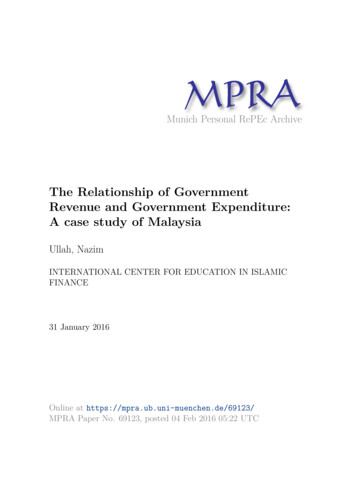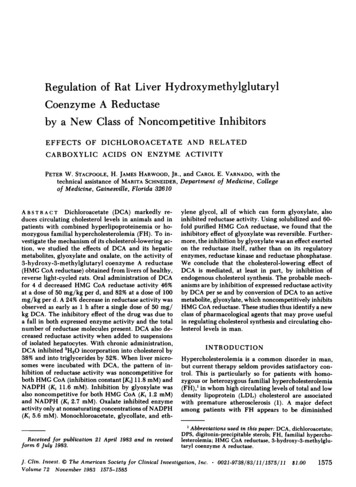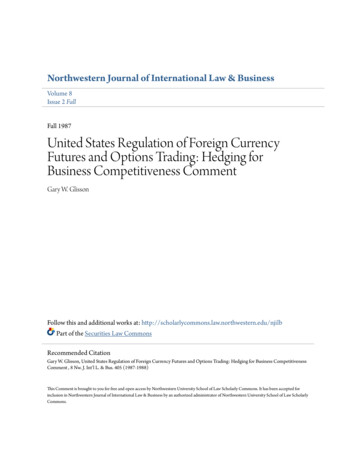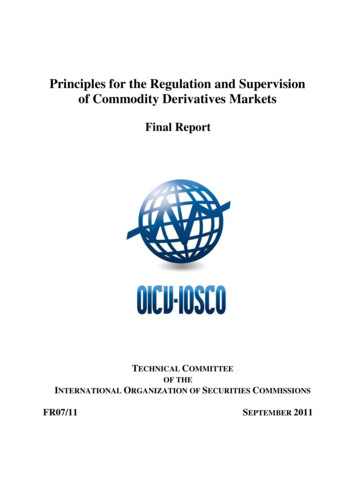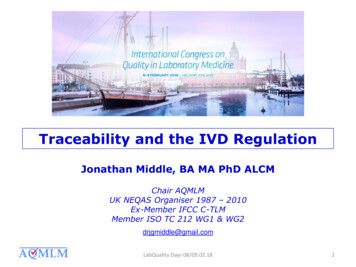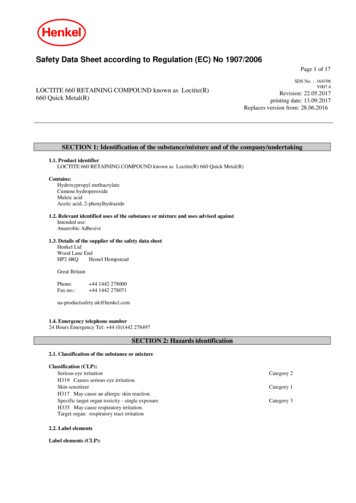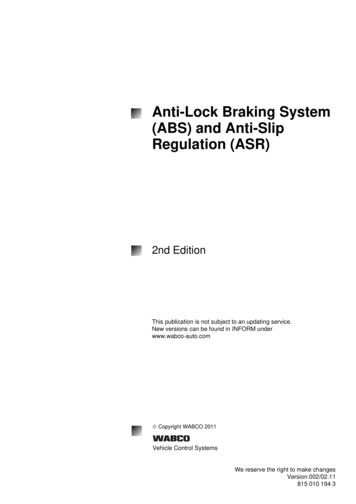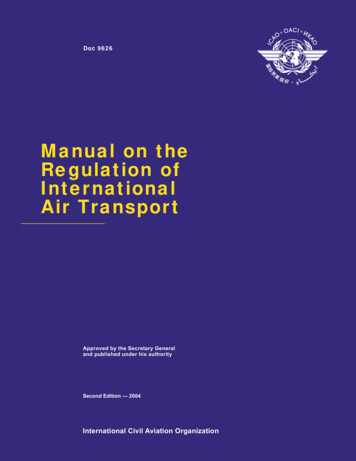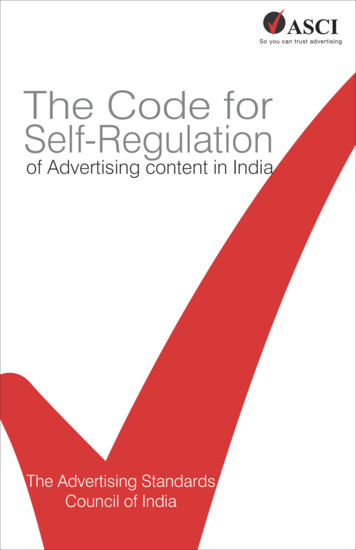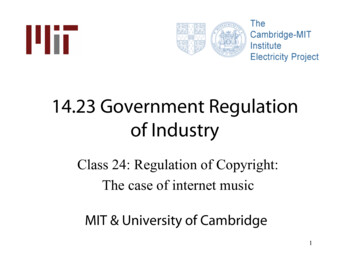
Transcription
14.23 Government Regulationof IndustryClass 24: Regulation of Copyright:The case of internet musicMIT & University of Cambridge1
Outline What is copyright?The History of NapsterEconomics of CopyrightThe recorded music industryImpact of file transfers on music industryShould we stop file transfers?2
History of Copyright 1445 Gutenberg Press - printing invented.1547 England’s Edward VI grants monopoly to King’s printer forcertain works. 1556 Charter granted the Stationer’s Companymonopoly over printing and powers to enforce.1707 external competition from Scots to break monopoly.English Copyright - Statute of Anne - 1709.– Legal protection for consumers of copyrighted works: Curtailment of the term of copyright.– Public domain for literature created: Copyright only for new works. Copyright limited to power to print, publish and sell (i.e. nocontrol of resale). Copyright belonged to author/creator.Essential Principles of this statute exist today.3
Extension of US Copyright Law 1790 - Books, maps and charts1802 - Prints1831 - Music1865 - Photographs1870 - Drama, paintings, drawings and sculpture1912 - Movies1964, 1976 - Computer Programs1971 - Records and tapes1976 - Dance1990 - Architecture1998 - Boat Hull designsWhat drives copyright scope extension?4
Limitations to copyright (US) Exclusions from infringement rules:– Non-profit musical performances– Radio musical performance in restaurants and smallbusinesses (1976)– Works of utility (a chair)– Expressions of fact (phone book)– Ideas vs. expression of ideas– Fair use– Parody and commentary Compulsory licenses of music for a predetermined fee. Why?5
Music Copyright Law and Enforcement(Sonny Bono Copyright Extension Act 98) For works created on or after January 1, 1978: copyright lasts for lifeof author plus 70 years (previously 50).For pre-1978 works still protected by their original or renewedcopyright: the total length of their copyright is extended to 95 years(previously 75) from the date the copyright was originally secured.For joint works of authorship, the term is measured by the life of thelongest-lived author.Works for hire (i.e. corporate), anonymous and pseudonymous works:copyright lasts for 95 years (previously 75) from the year of firstpublication or 120 years from the year of creation, whichever expiresfirst.Can sue for infringement of copyright but need to register works at theCopyright Office before you can sue.6
Fair Use: for and against?(Klein et al, 2002) Time and space shifting as ‘fair use’ - user benefitsexceed loss of income by a lot. Economic issue is whether benefit of this is indirectlyappropriable via higher prices and hence that it shouldbe permitted by copyright holders? Betamax case, Sony sued for allowing copying of TVprograms. However it is clear that this increases thevalue of the TV programs and copyright holders cancharge more. How is this different for copying an MP3 file?7
Napster A Northeastern U. undergraduate issues 1st pre-release version 1999Concept:– MP3 search engine– File sharing protocol– Communication tool within a communityHow it worked:– 1. Song title query sent to Napster server– 2. Receive client list with title hit– 3. Select and contact Client– 4. Transfer fileExplosive growth of downloads:– 1.1 million users Feb 2000– 6.7 million users Aug 2000– 13.6 million users Feb 20018
RIAA (Recording IndustryAssociation of America) reacts RIAA claimed no right to distribute, playingphonorecords without license, economic harm to artists. Napster claims fair use, non-commercial use, allowed tomake temporary copies (time and space shifting),lawful sharing: owners owned copies. Napster lose because can’t prove that its pay servicecould prevent all illegal copying in July 2001. Acquired by Bertelsmann (May 2002), eventualbankruptcy, sold for 5m in Nov 2002 to a CD-burnercompany, Roxio. Bertelsmann being sued for 17bnby9artists and music publishers.
The Economics of Copyright Key issue is efficiency of system vs the ‘distributional’consequences (as with patents). This gives rise to the optimal length and optimal scope ofcopyright protection. Length number of years for which legally enforceablemonopoly rights can be enforced. Scope the amount of ‘fair use’ that should be permittedwithout recourse to copyright owner e.g. private copyingof TV programmes for later viewing. In general it is accepted that copying for ‘time’ and ‘space’‘shifting’ is ‘fair use’.10
The Economics of Copyright The economic rationale for ‘fair use’ is that it increases thewelfare of the consumer without seriously reducing thewelfare of the producer and it saves on transaction costs ofnegotiating with copyright holder. Legal case for copyright can include moral right to benefitfrom created work. However we should remember that other incentivemechanisms have been devised to incentivise innovationand these may yield higher social welfare. e.g. statefunding for innovators, prizes for innovation, in houseinnovation. Is copyright necessary? Is music the same as ethical drugs?11
The Economics of Copyright Landes and Posner (1989) argue that the optimal level of copyright protectiondepends on:– The response of the number of works created to increase in protection (1)– The value of each extra work (2)– The response of the total cost of creating works with respect to number ofworks (3) and the degree of copyright protection (4)– Increases in 1 and 2 raise the optimal level of protection, increases in 3 and 4reduce it.The reason for limiting intellectual property is to reduce monopoly profits and toreducing tracing costs.Why have increasing copyright length and fixed date after death of author?– Falling cost of copying should raise optimal degree of protection.– All works should come out of copyright at same time to prevent problems12 ofdetermination of publication date and competition between old and new eds.
RIAA Year End 00Total Sales mCD Millions of Units12000700CD (units m)Total Sales m30040002002000100001990 1991 1992 1993 1994 1995 1996 1997 1998 1999 2000 2001 2002Source: Recording Industry Association of America (2000, 2003).13
The Music Industry 33.4bn (2001) sales world-wide of recorded music. 5 companies control the market: Sony, Universal,Warner, BMG (Bertelsmann) and EMI. Sony had 36bn (FY 2002) sales in electronics andcomputers. Universal up for sale. All losing money in music division. Sony innovating with music via mobiles. Apple seeking to market songs across internet. 14
Does the music industry needrecord companies? Economic characteristics of artists– capital constrained and risk averse– Market for talent very competitive Recording companies offer– economies of scale in distribution and advertising– deep pockets for advances– ability to spread risk Recording companies have– monopsony buying power in market for talent– oligopoly in market for distributed music– ability to segment market and price discriminate15
Effect of the internet on musiccompanies Market for recorded music - a vertically related industry Artist-Music Co-Recording Co-Distribution Channel The effect of the internet on this market:– Distribution costs drop to virtually zero.– Napster in competitive market for internet service provision.– Drastic innovation with possibly a large effect on recordingcompanies.– However this effect is debatable given willingness to pay forquality.16
How does illegal copying affectthe legitimate music market? Three sources of income in market:– Hard Copies– Broadcasts– Live Performances Most artists make most of their money from live performances Profits may fall because:– Losses in distribution channel (competitor network has arisen)– Illegal copies displace legitimate sales– Losses on falling radio audiences due to online listening– Unit of sale has changed reducing demand for pre-bundled17products i.e. move from compilation to single track
Lessons from history(Silva and Ramello, 2000) For three decades the recorded music industry has beensubject to illegal copying using tapes but sales havecontinued to grow. Copying only effects the full price segment of the marketwhere established artists make additional money fromroyalties. There are demand network externalities from copies.Sampling does lead to purchases of a full price copy. Thisis particularly the case in developing countries as incomegrows. Demand network externalities increase the demand for18live performances from the artists.
Lessons from history Illegal copies have served a useful function for the recordcompanies, in being a credible commitment to not reduceprices in the future. Consumers buy the high price versionnow knowing that there is little incentive for the recordcompanies to discount it in the future. Illegal copies create a new generation of listeners who willpurchase full price versions in due course (esp. students). Napster may be different to tapes because the quality of thereproduction is identical to the original and hence highwillingness to pay individuals have no incentive to paymore for quality.19
Did Napster effect sales? 2790m tracks downloaded using Napster inFeb. 2001. In August 3050m downloaded in August2001 on successors. KaZaa software downloaded 130m times Strong suggestion that file copying must bereducing sales.20
Economic Analysis of fileswapping (f.Romer, 2002) Assume 36bn music downloads per year. 2 per track (price of CD single 4) 72bn per year of consumer surplus.World-wide sales of recorded music 37bn (2000).Resource costs of CDs and transportation very significant.Compliance and legal costs of enforcing copyright imposeadditional costs on society. How might rest of economy be effected by sharp reductionin file downloads?21
What should happen? New charging strategies:– Apple, Sony initiatives ? Increased legal protection:– Suing Napster successors - this is difficult.– Suing ISPs who host downloading individuals.– Suing individuals responsible for file downloads. Other ways to incentivise creativity:– Taxes and subsidies– Rewards for innovation ?22
Conclusions Arguments for copyright protection are very similar to those forpatents. Copyright scope extension driven by new technology. Copyright length extension seems to be driven by market power. Napster and successors do seem to undermine record companies. New ways of enforcing copyright needed to protect electronicmaterial and creative responses by record companies required. However also need to recognise that demand for copyrightedmaterial is highly price elastic so it is worthwhile if muchmaterial is actually free. This may mean that finding new ways of paying the fixed costs of23creativity may be necessary.
Next Conclusion and Exam Syllabus24
The Music Industry 33.4bn (2001) sales world-wide of recorded music. 5 companies control the market: Sony, Universal, Warner, BMG (Bertelsmann) and EMI. Sony had 36bn (FY 2002) sales in electronics and computers. Universal up for sale. All losing money in music division. Sony innovating with music via mobiles.
